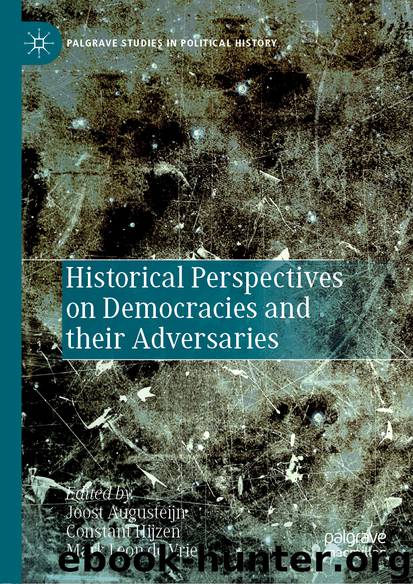Historical Perspectives on Democracies and their Adversaries by Joost Augusteijn & Constant Hijzen & Mark Leon de Vries

Author:Joost Augusteijn & Constant Hijzen & Mark Leon de Vries
Language: eng
Format: epub
ISBN: 9783030201234
Publisher: Springer International Publishing
Context of the Case: Communism as the Ultimate Adversary
In order to understand the discussion about ‘the movement’, we need to understand how the Dutch security service determined in general who posed a threat to the democratic order and who did not. The circumstances of the institutionalisation of the first domestic security service was of great influence on their threat perceptions. The establishment of the first security service, the Central Intelligence Service (Centrale Inlichtingendienst) in 1919, was the result of the fear that revolution would take place in the Netherlands, just as it had in Russia and—after the end of the First World War—seemingly in many other states too. Especially as a result of the scare of November 1918, as revolutionary unrest spread across Europe, most Western authorities, the Dutch included, increasingly perceived the internationalist revolutionary appeal as a threat to their democracies. 23 This fear became even more intense, when revolutionary unrest broke out in Germany. Dutch authorities feared that ‘the revolutionary flood would inexorably come westward’. 24
The cabinet, the mayors of the larger cities, the police, and the military wanted to know whether leftist parties and workers’ movements in the Netherlands aspired to take part in staging a revolution, as they had done in Russia and now in Germany. Ever since, Dutch social and political organisations on the extreme left, such as the Trotskyists, socialists, Bolsheviks, and communists have been considered extremist. In the eyes of the authorities, their radical political goals and their internationalism made them a threat to democratic order. The security service became a node for information on the strength of, support for, intentions, and possible future courses of actions of left extremist political of the workers’ movement. 25 Although it monitored a broad range of organisations, from pacifist organisations to Esperanto speakers and rightist clubs, the most important adversary of the democratic order and state—by far—was the revolutionary threat of socialism and communism. The security service tried to establish to what extent revolutionaries in The Netherlands, supported and/or inspired by extremists from abroad, were capable of and willing to bring revolution to The Netherlands. 26
The Central Security Service (Centrale Veiligheidsdienst), which was established on 9 April 1946 as the Cold War was unfolding, adhered to more or less the same threat perceptions. Western threat perceptions were structured after the communist party staged a coup in Czechoslovakia on 25 February 1948, triggering a firm anti-communist reaction of the Dutch public and parliament. Although neither the government nor the security service truly believed a military offensive of the Soviet Union or a coup by the Dutch communist party to be an imminent threat, it did reinforce the enemy image of communism. The scenario in Prague, the capital of a country with a democratic tradition of two decades, painted a telling picture of Stalin’s invisible hand and a group of internal enemies effectively abolishing democracy. An outside power might prepare a military invasion, whilst in the meantime it secretly sent spies and saboteurs to assume sensitive positions in order to sabotage the political and military machinery at the time of the invasion.
Download
This site does not store any files on its server. We only index and link to content provided by other sites. Please contact the content providers to delete copyright contents if any and email us, we'll remove relevant links or contents immediately.
The Secret History by Donna Tartt(18851)
The Social Justice Warrior Handbook by Lisa De Pasquale(12143)
Thirteen Reasons Why by Jay Asher(8799)
This Is How You Lose Her by Junot Diaz(6796)
Weapons of Math Destruction by Cathy O'Neil(6148)
Zero to One by Peter Thiel(5689)
Beartown by Fredrik Backman(5600)
The Myth of the Strong Leader by Archie Brown(5427)
The Fire Next Time by James Baldwin(5250)
How Democracies Die by Steven Levitsky & Daniel Ziblatt(5129)
Promise Me, Dad by Joe Biden(5088)
Stone's Rules by Roger Stone(5027)
A Higher Loyalty: Truth, Lies, and Leadership by James Comey(4846)
100 Deadly Skills by Clint Emerson(4840)
Rise and Kill First by Ronen Bergman(4705)
Secrecy World by Jake Bernstein(4648)
The David Icke Guide to the Global Conspiracy (and how to end it) by David Icke(4628)
The Farm by Tom Rob Smith(4439)
The Doomsday Machine by Daniel Ellsberg(4417)
